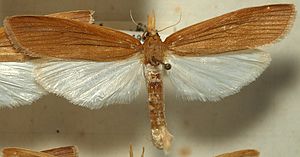Schoenobius gigantella
| Schoenobius gigantella | ||||||||||||
|---|---|---|---|---|---|---|---|---|---|---|---|---|

Schoenobius gigantella |
||||||||||||
| Systematics | ||||||||||||
|
||||||||||||
| Scientific name | ||||||||||||
| Schoenobius gigantella | ||||||||||||
| ( Denis & Schiffermüller ) |
Schoenobius giant ella is a butterfly from the family of Crambiden (Crambidae).
features
The moths reach a wingspan of 27 to 47 millimeters (according to another source from 25 to 30 millimeters for the males and 35 to 43 millimeters for the females). The fore wings of the males are quite broad and have a blunt apex . They are gray to ocher in color and have brown spots of varying degrees of development that indicate the transverse lines. There are two spots in the cell . All of these spots can also largely converge, they then form a longitudinal line that extends from the base to the outer edge of the wing. The hind wings are greyish and marked with an almost extinguished gray submarginal line and dark spots on the outer edge. The females have slimmer and narrower wings, the apex is pointed. The forewings are ocher colored and marked with very variably developed dark brown spots. They can either be almost absent or they can also be well developed and converge to form a longitudinal line in the middle and apical fields. The hind wings are white. The individual variability is very large, while the geographical variability is low. The form nigristriellus Popescu-Gorj, Olaru & Draghia , 1972 has yellowish ocher forewings with a broad brown longitudinal line. This form is common in the females while it is rare in the males. In the form of punctigerellus , the forewings are covered with numerous brownish spots. This form is also more common in females.
The caterpillars are yellowish white, have a brown head and a brown thoracic shield.
distribution
Schoenobius gigantella is widespread in Europe. Outside of Europe, the species is also found in China, Russia, Transbaikalia , Kazakhstan , Azerbaijan , Iran , Turkmenistan , Turkey and the desert regions of Palestine . There is no evidence from North Africa yet.
biology
The caterpillars feed on young reed shoots ( Phragmites australis ) and on swaths of water ( Glyceria maxima ). They pupate in the stem below an excursion hole that is closed with a web. The moths fly from April to August.
Systematics
The very similar species Schoenobius sasakii Inoue , 1982 and S. majoralis Hampson , 1896 were downgraded to subspecies of S. gigantella .
The following synonyms are known from the literature :
- Tinea gigantella [ Denis & Schiffermüller ], 1775
- Palparia gigantea Haworth , 1811
- Palparia fumea Haworth , 1811
- Topeutis gigantalis Huebner , 1825
- Chilo punctigerellus Stephens , 1829
- Chilo punctigerellus Stephens , 1834
- Chilo spurcatellus Walker , 1863
- Schoenobius gigantellus exits . punctivittellus Erfurth , 1933
- Schoenobius gigantellus f. nigristriellus Popescu-Gorj, Olaru & Draghia , 1972
supporting documents
- ↑ a b Patrice Leraut: Zygaenids, Pyralids 1 . In: Moths of Europe . 1st edition. Volume III. NAP Editions, 2012, ISBN 978-2-913688-15-5 , pp. 505 (English).
- ↑ a b c d e Barry Goater, Matthias Nuss, Wolfgang Speidel: Pyraloidea I (Crambidae, Acentropinae, Evergestinae, Heliothelinae, Schoenobiinae, Scopariinae) . In: P. Huemer, O. Karsholt, L. Lyneborg (eds.): Microlepidoptera of Europe . 1st edition. tape 4 . Apollo Books, Stenstrup 2005, ISBN 87-88757-33-1 , pp. 116 (English).
- ↑ a b Global Information System on Pyraloidea (GlobIZ). Retrieved October 20, 2014 .
- ↑ Schoenobius gigantella at Fauna Europaea. Retrieved October 20, 2014
Web links
- Schoenobius gigantella (DENIS & SCHIFFERMÜLLER, 1775). Lepiforum e. V .: Determination aid of the Lepiforum for the butterfly species found in Germany, Austria and Switzerland., Accessed on October 20, 2014 .
- Guide to the moths of Great Britain and Ireland. Schoenobius gigantella (Denis & Schiffermüller, 1775). Ian Kimber, accessed October 20, 2014 .